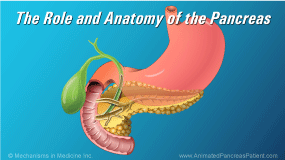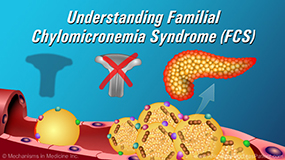The Role and Anatomy of the Pancreas
*Please note: This slide set represents a visual interpretation and is not intended to provide, nor substitute as, medical and/or clinical advice.
The pancreas is an important organ in the digestive system.
The pancreas is located in the upper abdomen, directly behind the stomach and next to the small intestine. In most adults it is between 6 and 10 inches long and 2 inches wide.
The pancreas is comprised primarily of a network of tubes or pancreatic ducts that release liquids into the upper portion of the small intestine called the duodenum.
Anatomically the pancreas is divided into three regions: the head, the body, and the tail.
The pancreas has two functions: endocrine and exocrine.
Its endocrine function is to produce the chemicals (hormones) that regulate blood sugar, such as insulin.
Its exocrine function is to produce enzymes that help us digest our food.
Pancreatic amylase breaks down carbohydrates, or starches, into glucose. Proteases break down protein into amino acids. And lipases break down fats.
Because these digestive enzymes are so powerful, they are wrapped in a protective layer while they are in the pancreas.
To reach the gastrointestinal tract, the digestive enzymes travel through the pancreatic ducts and are eventually released into the duodenum at the major papilla (also known as the ampulla of Vater).
Once they are completely out of the pancreas, the protective layer is removed and the enzymes become active.
Bile from the gallbladder also enters the duodenum at the major papilla.
Bile breaks apart fat into smaller fat droplets which are easier for lipase to digest.
When the pancreas is healthy, it contributes to a healthy digestive system. However, when our pancreas does not function correctly and is unwell, we can have trouble digesting food properly or maintaining our blood sugar in a healthy range.
Heavy alcohol consumption, high fat diets, eating large meals, being overweight, and tobacco products, can put stress on your pancreas causing it to work less well. There are also some genetic conditions that affect the pancreas, notably cystic fibrosis.
To help keep your pancreas healthy, eat a varied diet that is rich in fruits and vegetables, include fish and white meats as favored sources of protein, keep high fat foods and alcohol for special occasions, maintain a healthy weight, and watch your cholesterol and triglyceride levels.


























